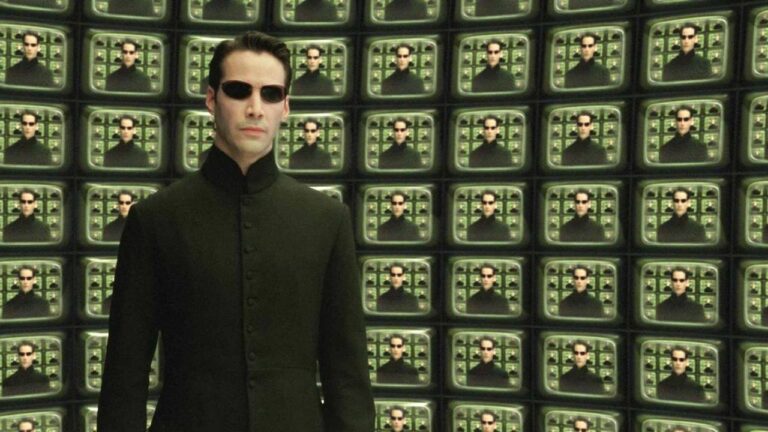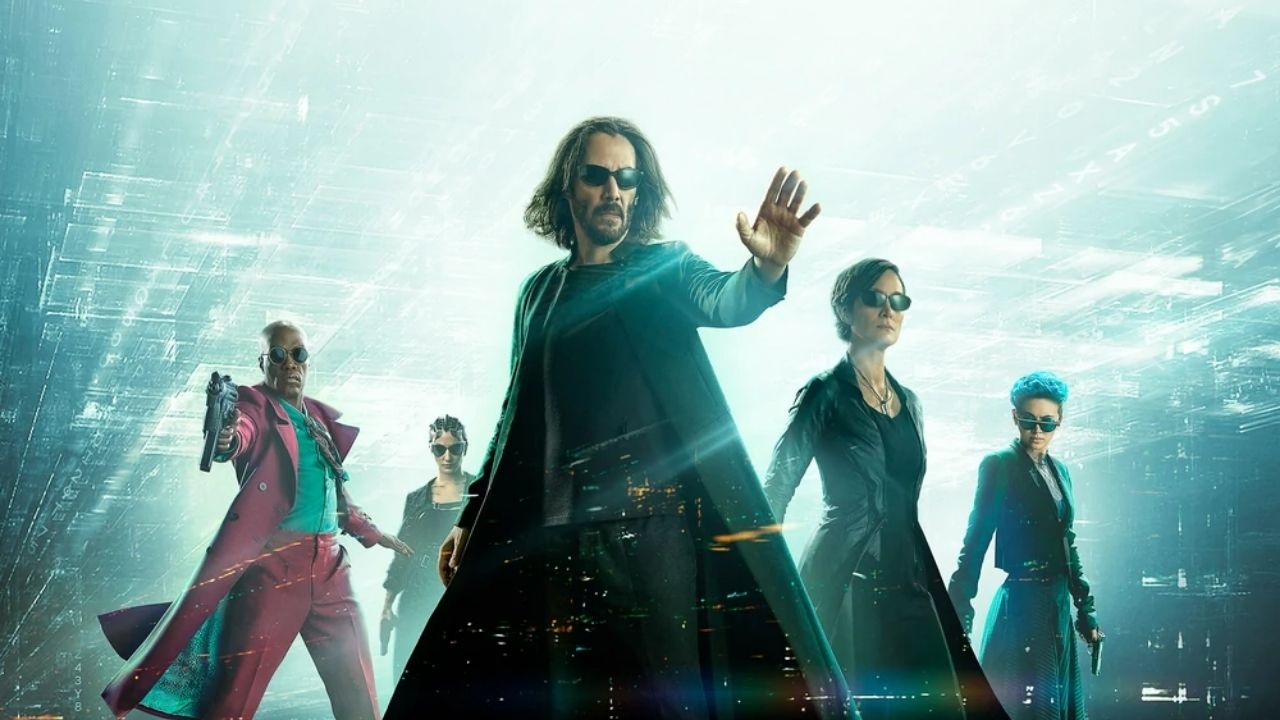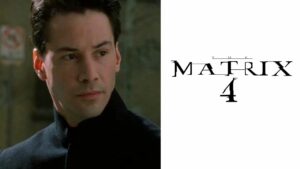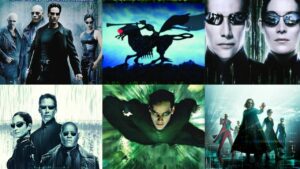Eighteen years after the trilogy, the most pertinent question is – Why? Why does this hybrid sequel-reboot even need to exist? There is no answer. I don’t think Lana Wachowski, Warner Bros, Keanu Reeves, or Carrie Ann-Moss have a definite answer either. So much so that the movie itself makes several references that question its own existence and creation. There is no answer.
However, beyond why it exists, lies the fact that The Matrix Resurrections is a celebration. It is an ode to the world that The Matrix created in virtual reality and in our minds. Its purposeless existence is exactly why it’s such a scream.
The last few months have been rife with ‘oh I haven’t seen The Matrix’. There is no shame in not having watched it, but I do have to say… watch The Matrix. I have spent 20 years telling people to watch The Matrix not because it has action sequences that defy physics or because the special effects are off the rails, but because the world I have grown up in has thrown up enough reason to question reality. Regularly.
There are sequels, spin-offs, reboots, and re-imaginations. The Matrix Resurrections isn’t not a reboot, but it isn’t a reboot either. It is not a sequel, because it is far removed from Reloaded and Revolutions. It’s a re-imagination because technically this should be The Matrix 1.5 and not 4. I’m going to ignore, for a moment, all of you that haven’t watched the original trilogy.
The Premise of The Matrix Resurrections
At the end of Revolutions, Trinity is dead as is Neo. Essentially, for the heavily scrutinized world of ‘making sense in the movies’, the writers had their work cut out if Neo and Trinity had to find their way back into the story. In world creation that relies so heavily on being meta, that basically meant that there would undoubtedly be a way back.
Consider this… what if Neo hadn’t followed the White Rabbit and taken the red pill? If he had chosen the blue pill, where would he be? Would he be a video game designer? Would he have just been a shadowy hacker? (Would we have been even vaguely familiar with the possibility that we’re living in a simulation or understand the scope, scale, and expanse of a digital world?). In the context of Resurrections, honestly, it doesn’t matter.

Thomas Anderson is a video game designer who has become somewhat of a legend – just like Neo, only in different worlds. I’m not sure if hearing him being called anything other than Neo or Mr. Anderson is going to be easy to get used to, but this piece has been written after just one watch. Giving you a run-down of the characters is a fruitless exercise considering the complete and total inconsequentiality of the film.
What is pertinent though, is the fact that the character design and tone is very similar to what we are used to from the first three installments. Much like us plebs that are often in awe of celebrities when we encounter them, the characters in Resurrections are ALL in awe of Neo. The characters you’ll remember are limited to Neo, Trinity, Niobe, Sati, Morpheus and Agent Smith – the last two in spirit more than appearance. Convoluted – I know… but part of the allure of The Matrix universe.

What is worth mentioning though is the fact that Carrie Ann-Moss and Keanu Reeves have aged like fine wine. You’re unlikely to look at either of them and judgmentally exclaim ‘what on earth happened to her/him.
Are the stunts as good?
There is also no shortage of gravity-defying and time-bending stunts. Lots of you are going to be looking for ‘bullet time’ and thankfully there is some bullet time, but skillful film-making and direction are illustrated by the fact that they haven’t overdone it. Bullet time had the potential to be an over-used gimmick but thankfully the advancement of technology is symbiotic with the evolution of the stunts in Resurrections.
Action sequences are heavily choreographed, and this is not always a bad thing if you’re a fan of raw, break-stuff action sequences from the ’90s.
The stunts and special effects truly have evolved. Not just in the sense of them being more over the top or death-defying, but more so in their usage and implementation in the story. Context is everything. The telephone exits have evolved, mirrors have evolved and fight sequences are more ingenious.
Thankfully, the 18 years that have passed were well used by Lana Wachowski to think about how to take individual sequences to the next level and make sure they have at least a semblance of the impact that the original did. Does she succeed? Yes and no.
Yes, because there are some truly jaw-dropping, complex sequences, and no, because none of them are seared into our brains the way the stunts in The Matrix. Or at least not in my brain.
Resurrections Still Pays Tribute to Hackers
The other thing that is more obvious now than it was in 1999, is the fact that this franchise is as much about hackers behind the scenes as it is about a bullet-stopping, flying super-hero. It is hard to deny the fact that thematically this film is pushed forward by largely out-of-sight genius hackers and nerds with massive complexes about themselves (like most nerds).

These nerds, both in our world and The Matrix world, essentially always need either a hero or an anti-hero that can highlight and turn their nerdiness into something actionable. But it does re-iterate that ultimately, the meek will inherit the earth and that nerds are the ultimate rock stars.
How good is The Matrix 4 storyline?
The goth style hits home and there really is no argument against this. (One day I am going to attempt to wear Morpheus’ yellow suit and it will be glorious). The production design is just as striking as the first three films if not slightly better thanks to the advancements in technology – both in our world and The Matrix world.
The dialogue is just as theatrical and over the top as the original. I am hard-pressed not to describe this experience as slick but considering how The Matrix is a benchmark in slick, I’m torn. How about this then… Resurrections is slicker than pretty much anything else that has come out since The Matrix. The overtly profound sounding lines boil down to being pointless but are so catchy that you will almost certainly embarrass yourself trying to use some of them.
So here’s how it goes as quickly as possible. Thomas Anderson (Keanu Reeves) believes his shrink (Neil Patrick Harris) is trying to help him deal with visions and potentially fictitious memories by keeping him on blue pills. Essentially this makes him semi-brainwashed, but the doubt that there is something else going on is visible on his face. Bugs (Jessica Henwick) – a hacker with a conviction and a team behind her, comes to yank Neo out of his simulation and re-introduce him to the real world.
There are numerous complexities of modals and portals which I’ll leave you to discover when you watch the film, but the ever-familiar red-pill, Morpheus (Yahya Abdul-Mateen II), the big white empty room and the one v one is soothingly familiar. The one v one between Neo and Morpheus however doesn’t hit nearly as hard as it did with Lawrence Fishburne in ’99.

The re-introduction of a poorly aged Niobe (Jada Pinkett-Smith) as the leader of the resistance leaves her severely under-utilized and the character of grown-up Sati (Priyanka Chopra Jonas) is so forgettable that it truly begs the question of whether she cast just to help Warner Bros avoid lack of diversity criticism. Agent Smith (Jonathan Groff) is a different flavor to Hugo Weaving’s Agent Smith. Not better or worse. Just different and fortunately more than watchable. The good vs evil ensues from here with the odd twist ensuring the re-boot doesn’t become predictable or monotonous.
The most striking difference between the first and this fourth film. The general focus of The Matrix is centered around the dimension in which an awakened Neo battles to save the real world from inside the Matrix with the attacks from the Sentinels being fought off by the resistance in the real world.
Resurrections dips its toes into all dimensions but make the transitions between them far softer. There is certainly a far more elaborate illustration of The Matrix world and its functioning with coffee shops, doctors’ offices, and just… life. The idea that this simulated world is not as good as the real world is debatable and Resurrections makes the debate fun.
The Matrix vs The Matrix Resurrections: Does the sequel live up to the name?
Here’s the bottom line. The Matrix Resurrections doesn’t take itself too seriously. The Matrix did. This stark difference in attitude and the heightened sense of self makes this film very watchable.

Dialogues from the meetings in the offices of the Deus Machina (the company Thomas Anderson works at) like, “Our beloved parent company, Warner Bros., has decided they will make a sequel to the trilogy,” “with or without the creators” is a tool of self-deprecation that is so cleverly turned into humor that the only other parallel that comes to mind is Deadpool.
Yes, this film thrives on nostalgia levels from audiences like me but the slightest bit of discernment makes it evident that the world of cinema has evolved manifold since 1999: Storytelling has evolved manifold and, fortunately, or unfortunately, audiences too have evolved. Has Lana Wachowski destroyed the legacy? Nope. In fact she has most skillfully preserved the folk-lore, with the potential for more.
What this boils down to in story-telling realms, is that the writing is undeniably less profound and its effect on the audience, far less ambitious. However, from personal experience of analyzing sequels, one of the greatest problems when leaving a cinema after watching one, is the feeling that ‘nothing happened. Literally. What was that about and at the end of it… nothing really happened. Resurrections, in my opinion, doesn’t suffer from this problem. Things do happen.
The plot does actually form lines that begin somewhere and end somewhere albeit with far less depth or gravitas than that which The Matrix offered in 1999. Has Lana Wachowski over-exploited our nostalgia and milked the franchise? No. Is the film slightly underwhelming based on your expectations from 1999? Yes.
Is any of this a problem?

Unless you want to leave the cinema feeling like a sage who is going to predict the end of the world, the coming of the machines, and AI bringing about the fall of society… no it’s not. Abandon the bad experiences you’ve had with sequels, ignore the feelings you had that made The Matrix cult. ‘Here’s the thing about feelings… they’re easier to control than facts‘.
So should you watch The Matrix Resurrections? ‘Choice is an illusion. You already know what you have to do…’
About The Matrix: Resurrections
The Matrix: Resurrections will serve as the fourth instalment to the American cyberpunk franchise The Matrix. It is produced, co-written and co-directed by Lana Wachowski who has written for the previous Matrix movies as well.
Keanu Reeves and Carrie Ann-Moss will reprise their roles of Neo and Trinity, respectively. Joining them is Jada Pinkett Smith as Niobe, Lambert Wilson as The Merovingian and Daniel Bernhardt as Agent Johnson.









No Comments on Was The Matrix Resurrections something we needed? A not review.